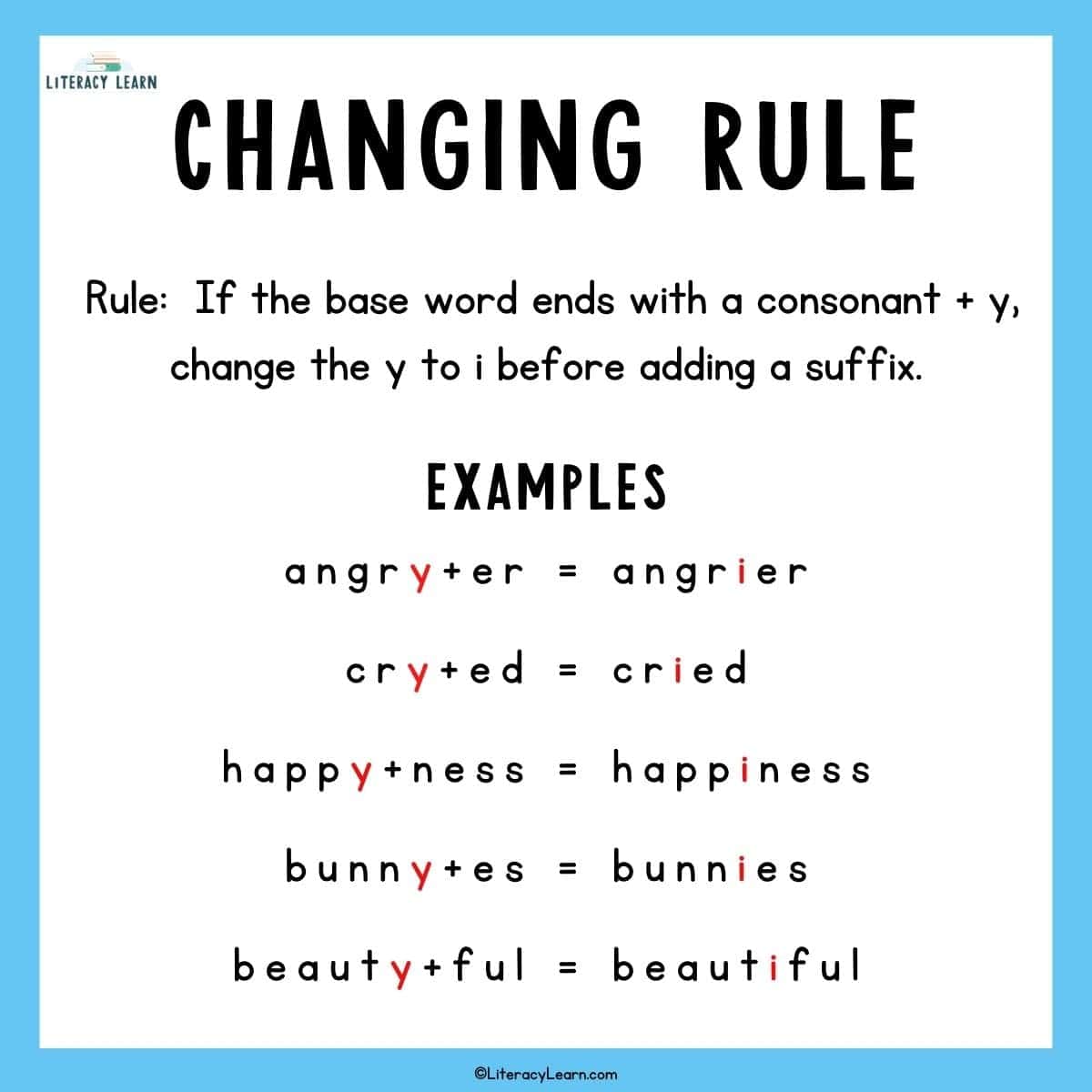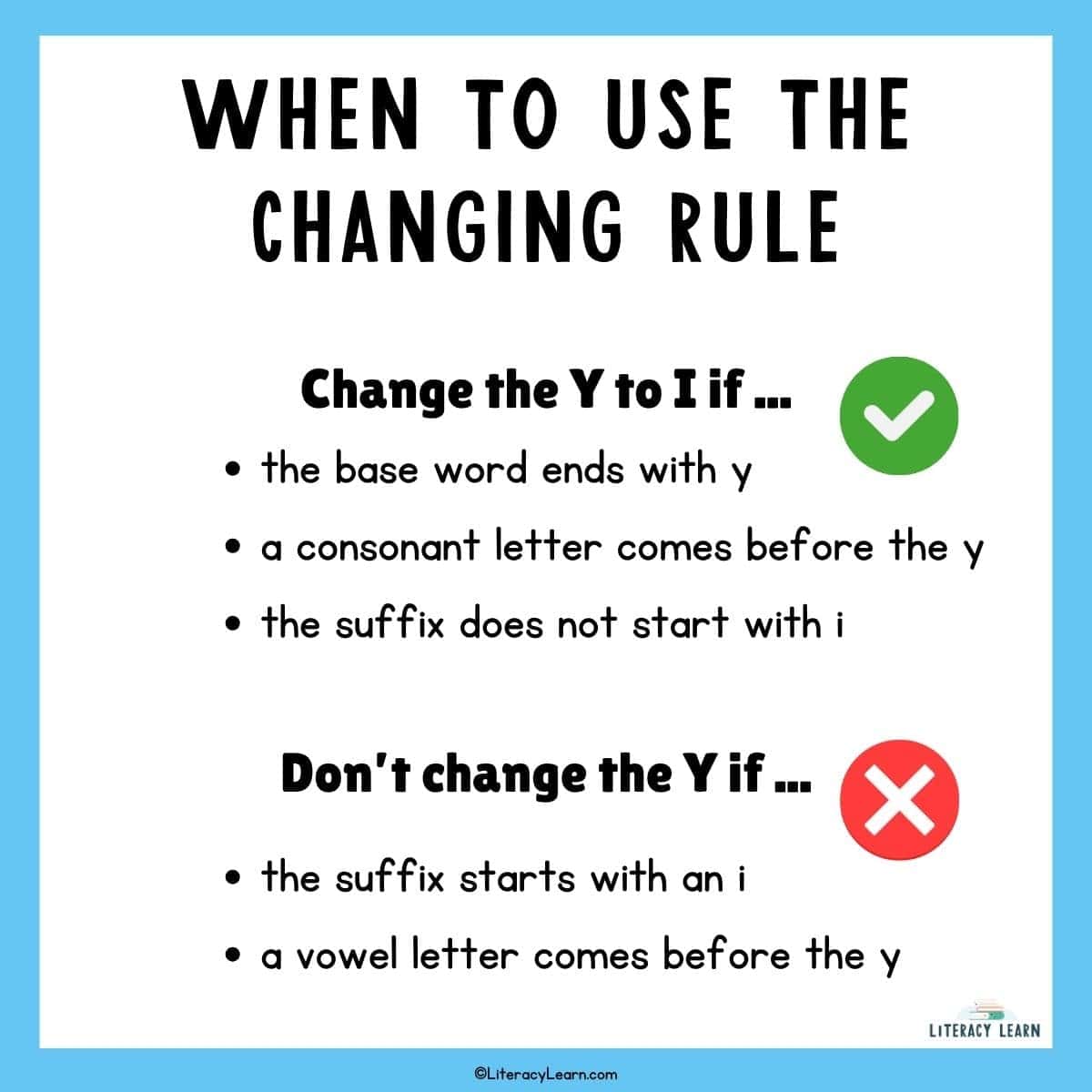The Changing Rule (Y to I Rule) + Free Printable
This post may contain affiliate links. As an Amazon affiliate, we earn from qualifying purchases.
Learn all about the Changing Rule with step-by-step teaching instructions. Plus, grab a free printable to make teaching and practicing this rule simple and effective!

All About the Changing Rule
The Changing Rule is a key spelling rule to teach your students—it really makes a difference in their spelling success!
That’s because the rule helps students understand how to spell words that end in Y correctly when a suffix is added.
➡️ Changing Rule: If a word ends with a consonant+y, change the y to i before adding a suffix (as long as the suffix does not start with the letter i).

When to Use the Changing Rule
Let’s unpack the definition a bit and provide some examples for clarity.
Here is the criteria for applying the changing rule:
☑️ The word ends with the letter Y.
☑️ The letter right before the Y is a consonant letter.
☑️ The suffix does not start with the letter i.
Example Words:
In all of the following words, you’ll notice that the word ends with Y, the letter before the Y is a consonant, and the suffix does not start with the letter i.
- cry + ed = cries
- sky + es = skies
- busy + est = busiest
- funny + er = funnier
- crazy + ly = crazily

When NOT to Use the Changing Rule
Just as important as knowing when to use the changing rule is knowing when not to use it!
Look out for these things in words that tell you NOT to apply the changing rule:
❌ The suffix starts with the letter i (most commonly, suffix -ing).
❌ The letter right before the Y is a vowel letter (usually part of a vowel team like ay, ey, oy, uy, au, or aw).
In these words, the letter y stays when adding the suffix.
Example Words:
- play + er = player (the letter before the y is a vowel).
- empty + ing = emptying (the suffix starts with a vowel).
More About the Changing Rule
In English, there are three “Great Suffix Spelling Rules.” These include the doubling rule, the dropping rule, and the changing rule.
While the doubling and dropping rule only apply to suffixes that start with vowel letters, the changing rule applies to suffixes that start with both vowel AND consonant letters.
The changing rule is the most complex of all three rules, and is usually taught after the others. It’s not as clearcut as the others and has more exceptions, so that’s why it’s important to provide clear instruction and lots of practice.
Here are some additional things you need to know about the changing rule:
- As it relates to the common suffix suffix -s/-es: When a word ends with the letter y, add you want to make it plural or 3rd person singular, you must change the y to i and then add on -es.
👉🏼 Examples: berry + es = berries, cry + es = cries, fancy + es = fancies - As it relates to the letter y. The rule is applied whether y is the last letter in a base word OR the last letter in a suffix.
👉🏼 Example: In a word like rusty, the -y is a suffix. If we add on another suffix -est, the rule still applies. The y is dropped and the word is spelled rustiest.
Teaching the Changing Rule
In order for kids to be successful with this concept, kids must know these things:
- Differences between vowels and consonants
- Basic morphology terms like morpheme, suffix and base words
- Common vowel teams like ay, ey, uy and diphthong oy
- Basic knowledge of V/V words
- Vowel sounds of the letter Y
Step-by-Step Teaching Instructions
- Show a list of base words that end with a consonant + y: sky, penny, cry, silly, sloppy.
- Ask students:
Q: What letter do all these words end with? (y)
Q: What kind of letter is right before the y? (a consonant) - Tell students: Today we are going to learn a new spelling rule called the changing rule. It’s going to apply to words like this, words that end with the letter y and have a consonant right before it.”
- Show a list of suffixes like -er, -es, -est, -ly. Remind students: A suffix is a meaninful word part (morpheme) added to the end of a word to change it.
- Explain the Rule: If the word ends with a consonant+y, change the y to i before adding a suffix (so long as it does not start with the letter i).
- I DO: Provide explicit instruction as you demonstrate why and how you change the y to an i in the following words.
- clumsy + er → clumsier
- penny +es → pennies
- silly + est → silliest
- sloppy +ly → sloppily
- play +er → player* explain that you don’t change the Y because the letter before the y is a vowel.
- cry+ ing → crying* explain that you don’t change the Y because the suffix starst with an i.
- WE DO: Practice together: Using new words, go through the process of ‘testing each word,’ determining if the y gets changed.
- happy + ness → happiness
- dry + es → dries
- toy + s → toys
- defy + ing → defying
- YOU DO: Provide students with the free printable worksheet to practice independently.
Using the Worksheet
We’re sharing this free worksheet (download below!) that gives kids practice applying the changing rule when spelling.

For all 12 words, your student will…
- Read the word sums (base words + suffixes)
- Use the chart at the top of the printable “test the word.” (If all three columns are yes, then the y changes to i.)
- Rewrite the words, applying the rule, if needed, and spelling the words correctly.
After completing this assignment, discuss if and why the y was changed. Take time to discuss word meanings, particularly how the suffixes change the meaning of words. Ask your child to select at least two of the words and use them in one sentence.
More Spelling Resources
Freebie: Pinpoint exactly what spelling concepts your students have mastered by using a spelling inventory.
Learn more: For students struggling with tricky words, learn about 7 of the best spelling strategies to help them be successful.

More no-prep practice:
Download & Print
DOWNLOAD TERMS: All of our resources and printables are designed for personal use only in homes and classrooms. Each teacher must download his or her own copy. You may not: Save our files to a shared drive, reproduce our resources on the web, or make photocopies for anyone besides your own students. To share with others, please use the social share links provided or distribute the link to the blog post so others can download their own copies. Your support in this allows us to keep making free resources for everyone! Please see our Creative Credits page for information about the licensed clipart we use. If you have any questions or concerns regarding our terms, please email us. Thank you!
➡️ Get MORE Freebies: Doubling Rule, Dropping Rule
We’d love to hear about your experience using this resource and value your feedback!
Please leave a comment below or tag us on Instagram @literacylearn.

